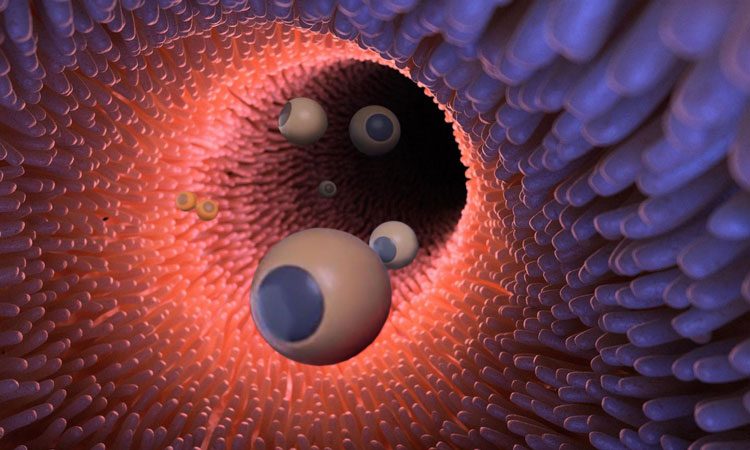Microrobots could be used to deliver drugs inside the body
Posted: 30 July 2019 | European Pharmaceutical Review | No comments yet
Scientists have developed microrobots that can deliver medication to specific spots inside the body while being controlled from outside the patient.


An artist's illustration of microrobots inside the gut (credit: Caltech).
Researchers at Caltech’s Division of Engineering and Applied Science are working on a new form of drug delivery – microrobots that can deliver medication to specific spots inside the body while being monitored and controlled from outside the body.
A joint research project from Lihong Wang and Wei Gao, the microrobots are intended for treating tumours in the digestive tract. They consist of microscopic spheres of magnesium metal coated with thin layers of gold and parylene. The layers leave a circular portion of the sphere uncovered – the uncovered portion of the magnesium then reacts with fluids in the digestive tract, generating bubbles which propels the sphere forward until it collides with nearby tissue.
To turn the magnesium spherical microrobots into a vehicle for delivering medication, the scientists first layered medication between an individual microsphere and its parylene coat. Then, to protect the microrobots from the harsh environment of the stomach, they were enveloped in microcapsules made of paraffin wax.
To then deliver drugs to the desired location, the team used photoacoustic computed tomography (PACT), which uses pulses of infrared laser light. The infrared laser light diffuses through tissues and is absorbed by oxygen-carrying hemoglobin molecules in red blood cells, causing the molecules to vibrate ultrasonically. These ultrasonic vibrations are picked up by sensors pressed against the skin. The data from those sensors is then used to create images of the internal structures of the body.
…the team used photoacoustic computed tomography (PACT), which uses pulses of infrared laser light
Imaging is an important role of the technique. By using PACT, the researchers can find tumours in the digestive tract and also track the location of the microrobots. Once the microrobots arrive in the vicinity of the tumour, a high-power continuous-wave near-infrared laser beam is used to activate them. Because the microrobots absorb the infrared light so strongly, they briefly heat up, melting the wax capsule surrounding them, exposing them to digestive fluids.
At that point, the microrobots’ bubble jets activate and the microrobots begin swarming. The jets are not steerable, so the microrobots will not all hit the targeted area, but many should. When they do, they stick to the surface and begin releasing the medication.
Tests in animal models show that the microrobots perform as intended, but Gao and Wang say they are planning to continue pushing the research forward: “We demonstrated the concept that you can reach the diseased area and activate the microrobots,” Gao said. “The next step is evaluating the therapeutic effect of them.”
Related topics
Data Analysis, Drug Delivery Systems, Imaging, Research & Development (R&D), Technology









